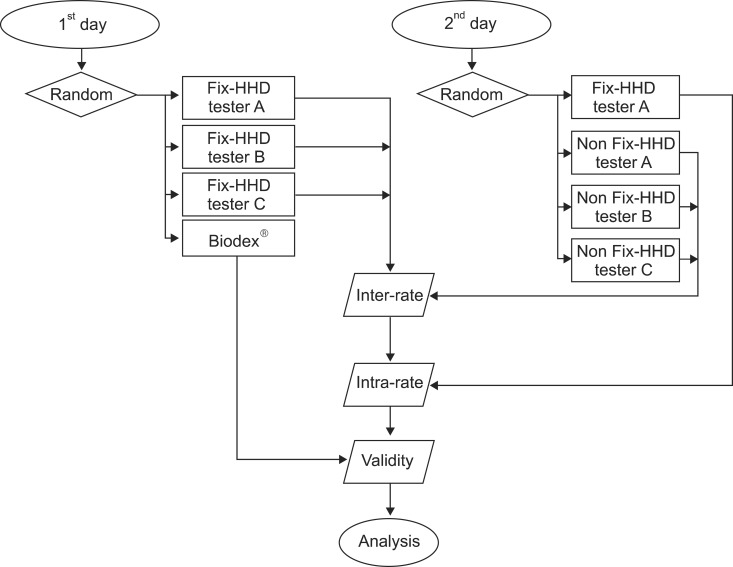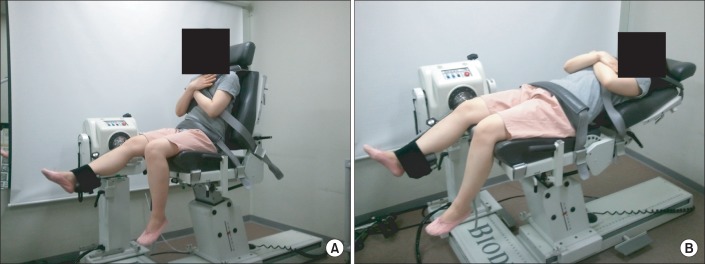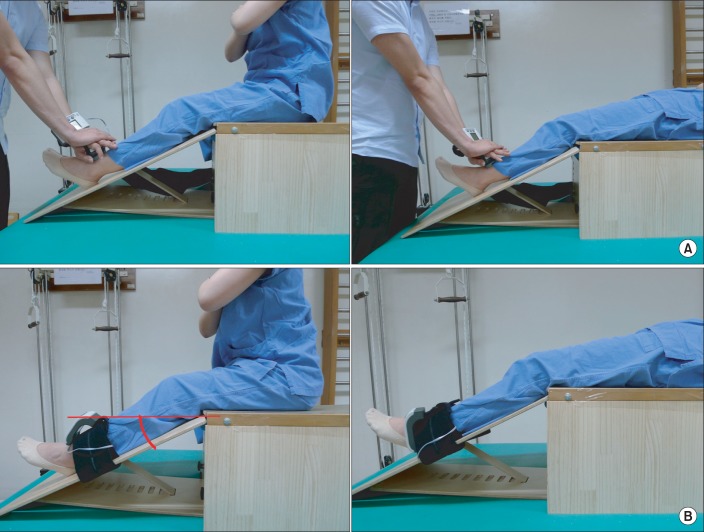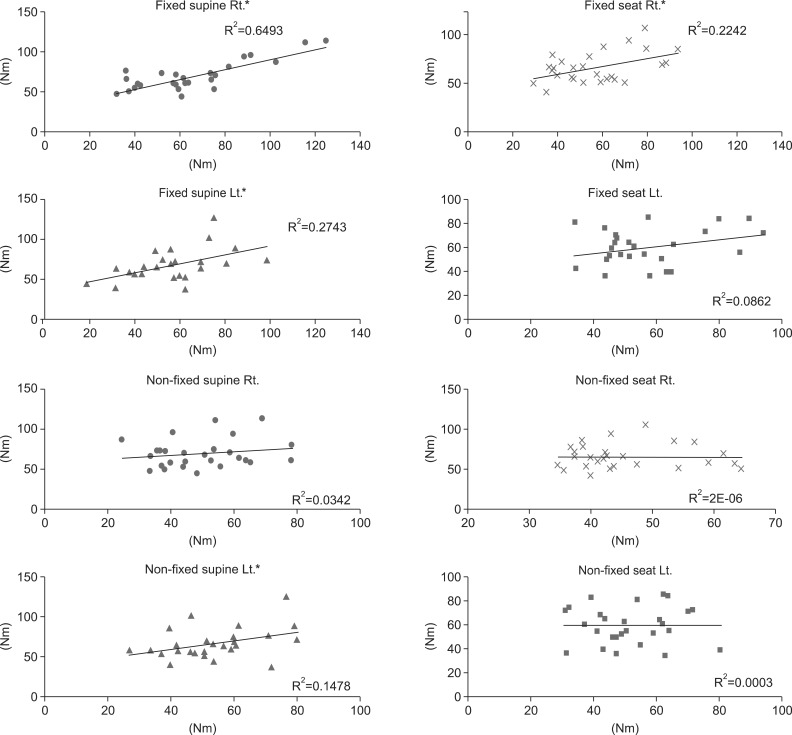Ann Rehabil Med.
2014 Feb;38(1):84-93. 10.5535/arm.2014.38.1.84.
Reliability and Validity of Isometric Knee Extensor Strength Test With Hand-Held Dynamometer Depending on Its Fixation: A Pilot Study
- Affiliations
-
- 1Department of Physical Medicine and Rehabilitation, Chung-Ang University College of Medicine, Seoul, Korea. miryjy@hanmail.net
- KMID: 2266545
- DOI: http://doi.org/10.5535/arm.2014.38.1.84
Abstract
OBJECTIVE
To determine the reliability and validity of hand-held dynamometer (HHD) depending on its fixation in measuring isometric knee extensor strength by comparing the results with an isokinetic dynamometer.
METHODS
Twenty-seven healthy female volunteers participated in this study. The subjects were tested in seated and supine position using three measurement methods: isometric knee extension by isokinetic dynamometer, non-fixed HHD, and fixed HHD. During the measurement, the knee joints of subjects were fixed at a 35degrees angle from the extended position. The fixed HHD measurement was conducted with the HHD fixed to distal tibia with a Velcro strap; non-fixed HHD was performed with a hand-held method without Velcro fixation. All the measurements were repeated three times and among them, the maximum values of peak torque were used for the analysis.
RESULTS
The data from the fixed HHD method showed higher validity than the non-fixed method compared with the results of the isokinetic dynamometer. Pearson correlation coefficients (r) between fixed HHD and isokinetic dynamometer method were statistically significant (supine-right: r=0.806, p<0.05; seating-right: r=0.473, p<0.05; supine-left: r=0.524, p<0.05), whereas Pearson correlation coefficients between non-fixed dynamometer and isokinetic dynamometer methods were not statistically significant, except for the result of the supine position of the left leg (r=0.384, p<0.05). Both fixed and non-fixed HHD methods showed excellent inter-rater reliability. However, the fixed HHD method showed a higher reliability than the non-fixed HHD method by considering the intraclass correlation coefficient (fixed HHD, 0.952-0.984; non-fixed HHD, 0.940-0.963).
CONCLUSION
Fixation of HHD during measurement in the supine position increases the reliability and validity in measuring the quadriceps strength.
Keyword
MeSH Terms
Figure
Cited by 2 articles
-
Relationship Between Respiratory Muscle Strength and Conventional Sarcopenic Indices in Young Adults: A Preliminary Study
Hee Joon Ro, Don-Kyu Kim, Sang Yoon Lee, Kyung Mook Seo, Si Hyun Kang, Hoon Chang Suh
Ann Rehabil Med. 2015;39(6):880-887. doi: 10.5535/arm.2015.39.6.880.Knee Extensor Strength Measurement in Patients With Limited Physical Activity Using a Supine Dynamometer Anchoring Frame
Min-Yong Lee, Kwan-Sik Sung, Hyungsuk Ham, You Gyoung Yi, Hyung-Ik Shin
Ann Rehabil Med. 2020;44(6):502-509. doi: 10.5535/arm.20056.
Reference
-
1. Bean JF, Kiely DK, Herman S, Leveille SG, Mizer K, Frontera WR, et al. The relationship between leg power and physical performance in mobility-limited older people. J Am Geriatr Soc. 2002; 50:461–467. PMID: 11943041.2. Suzuki T, Bean JF, Fielding RA. Muscle power of the ankle flexors predicts functional performance in community-dwelling older women. J Am Geriatr Soc. 2001; 49:1161–1167. PMID: 11559374.
Article3. Lauretani F, Russo CR, Bandinelli S, Bartali B, Cavazzini C, Di Iorio A, et al. Age-associated changes in skeletal muscles and their effect on mobility: an operational diagnosis of sarcopenia. J Appl Physiol. 2003; 95:1851–1860. PMID: 14555665.
Article4. Al Snih S, Markides KS, Ottenbacher KJ, Raji MA. Hand grip strength and incident ADL disability in elderly Mexican Americans over a seven-year period. Aging Clin Exp Res. 2004; 16:481–486. PMID: 15739601.
Article5. Brinker MR, Cuomo JS, Popham GJ, O'Connor DP, Barrack RL. An examination of bias in shoulder scoring instruments among healthy collegiate and recreational athletes. J Shoulder Elbow Surg. 2002; 11:463–469. PMID: 12378165.
Article6. Incel NA, Ceceli E, Durukan PB, Erdem HR, Yorgancioglu ZR. Grip strength: effect of hand dominance. Singapore Med J. 2002; 43:234–237. PMID: 12188074.7. Knapik JJ, Wright JE, Mawdsley RH, Braun JM. Isokinetic, isometric and isotonic strength relationships. Arch Phys Med Rehabil. 1983; 64:77–80. PMID: 6824423.8. Farrell M, Richards JG. Analysis of the reliability and validity of the kinetic communicator exercise device. Med Sci Sports Exerc. 1986; 18:44–49. PMID: 3959863.
Article9. Drouin JM, Valovich-mcLeod TC, Shultz SJ, Gansneder BM, Perrin DH. Reliability and validity of the Biodex System 3 Pro isokinetic dynamometer velocity, torque and position measurements. Eur J Appl Physiol. 2004; 91:22–29. PMID: 14508689.10. Feiring DC, Ellenbecker TS, Derscheid GL. Test-retest reliability of the Biodex isokinetic dynamometer. J Orthop Sports Phys Ther. 1990; 11:298–300. PMID: 18796902.
Article11. Toonstra J, Mattacola CG. Test-retest reliability and validity of isometric knee flexion and extension measurement using three methods of assessing muscle strength. J Sport Rehabil. 2012; 9. 04. [Epub]. http://journals.humankinetics.com/jsr-technical-reports/jsr-technical-reports/testndashretest-reliability-and-validity-of-isometric-knee-flexion-and--extension-measurement-using-3-methods-of-assessing-muscle-strength.12. Scott DA, Bond EQ, Sisto SA, Nadler SF. The intra- and interrater reliability of hip muscle strength assessments using a handheld versus a portable dynamometer anchoring station. Arch Phys Med Rehabil. 2004; 85:598–603. PMID: 15083436.
Article13. Kollock RO Jr, Onate JA, Van Lunen B. The reliability of portable fixed dynamometry during hip and knee strength assessments. J Athl Train. 2010; 45:349–356. PMID: 20617909.
Article14. Keating JL, Matyas TA. The influence of subject and test design on dynamometric measurements of extremity muscles. Phys Ther. 1996; 76:866–889. PMID: 8710966.
Article15. Stark T, Walker B, Phillips JK, Fejer R, Beck R. Hand-held dynamometry correlation with the gold standard isokinetic dynamometry: a systematic review. PM R. 2011; 3:472–479. PMID: 21570036.
Article16. Thorborg K, Bandholm T, Holmich P. Hip- and knee-strength assessments using a hand-held dynamometer with external belt-fixation are inter-tester reliable. Knee Surg Sports Traumatol Arthrosc. 2013; 21:550–555. PMID: 22773065.
Article17. Woods S, Bridge T, Nelson D, Risse K, Pincivero DM. The effects of rest interval length on ratings of perceived exertion during dynamic knee extension exercise. J Strength Cond Res. 2004; 18:540–545. PMID: 15320662.
Article18. Maffiuletti NA, Lepers R. Quadriceps femoris torque and EMG activity in seated versus supine position. Med Sci Sports Exerc. 2003; 35:1511–1516. PMID: 12972870.
Article19. Walsworth M, Schneider R, Schultz J, Dahl C, Allison S, Underwood F, et al. Prediction of 10 repetition maximum for short-arc quadriceps exercise from hand-held dynamometer and anthropometric measurements. J Orthop Sports Phys Ther. 1998; 28:97–104. PMID: 9699159.
Article20. Knapik JJ, Wright JE, Mawdsley RH, Braun J. Isometric, isotonic, and isokinetic torque variations in four muscle groups through a range of joint motion. Phys Ther. 1983; 63:938–947. PMID: 6856681.
Article21. Stratford PW, Balsor BE. A comparison of make and break tests using a hand-held dynamometer and the Kin-Com. J Orthop Sports Phys Ther. 1994; 19:28–32. PMID: 8156061.
Article22. Deones VL, Wiley SC, Worrell T. Assessment of quadriceps muscle performance by a hand-held dynamometer and an isokinetic dynamometer. J Orthop Sports Phys Ther. 1994; 20:296–301. PMID: 7849749.
Article23. Taylor JR. An introduction to error analysis: the study of uncertainties in physical measurements. 2nd ed. Sausalito, CA: University Science Books;1999.24. Visser JJ, Hoogkamer JE, Bobbert MF, Huijing PA. Length and moment arm of human leg muscles as a function of knee and hip-joint angles. Eur J Appl Physiol Occup Physiol. 1990; 61:453–460. PMID: 2079066.
Article
- Full Text Links
- Actions
-
Cited
- CITED
-
- Close
- Share
- Similar articles
-
- Reliability and Validity of a New Method for Isometric Back Extensor Strength Evaluation Using A Hand-Held Dynamometer
- Knee Extensor Strength Measurement in Patients With Limited Physical Activity Using a Supine Dynamometer Anchoring Frame
- Trunk Muscles Strength as a Risk Factor for Nonspecific Low Back Pain: A Pilot Study
- Reliability and Validity of the Martin Vigorimeter for Grip Strength Measurement in Korean Adults
- Evaluation of the Knee Extension Force in Korean Adults Using a Manual Muscle Tester





